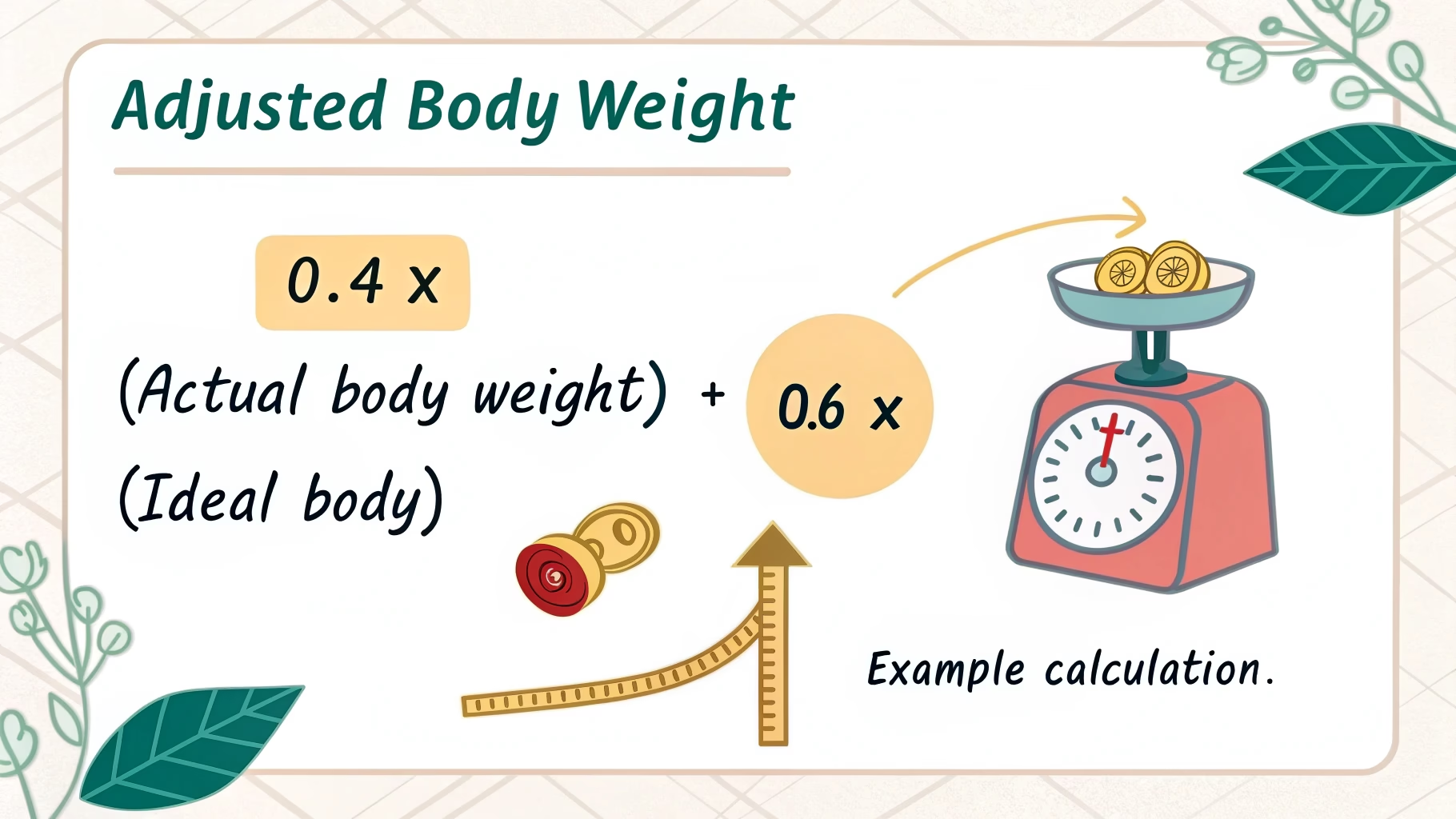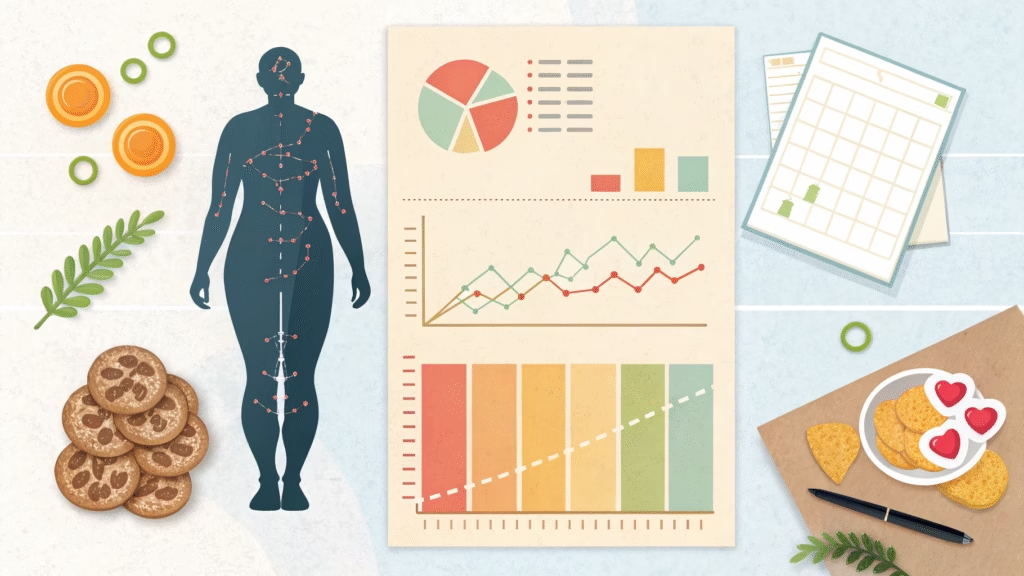Learn how to use the Adjusted Body Weight Formula to calculate accurate body weight for better health, fitness, and nutrition results.

An anonymous writer said: “A diet is the short period of deprivation that precedes weight gain.”
Indeed, it is a scientifically proven fact that, when it comes to losing weight, crash diets are ineffective in terms of results.
In France in 2009, according to Obésité Santé magazine, 6.5 million people were affected by obesity, representing 14.5% of the adult population.
In addition, 56.8% of men and 40% of women are overweight (obesity and overweight combined in the body mass index).
To lose weight or get closer to your ideal weight and stay in good physical shape, it is better to exercise and do regular physical activity than to deprive yourself of food and be sedentary throughout the week.
In this article, we look at methods for determining your ideal weight, i.e., the weight at which you feel good about your body and yourself.
Calculating your ideal weight: why worry about your body size?
First of all, why focus on body fat instead of simply trying to feel good?
Nowadays, media society and corporate culture—which emphasize speed, profitability, performance, dynamism, and responsiveness—severely condemn obesity as well as thinness, viewing both as noncompliant with social norms.
In fact, anyone who is too thin—even emaciated, with muscles like straw—or, conversely, overweight, is stigmatized by society for not conforming to informal social control and the draconian Western aesthetic codes mainly induced by the media and advertising.
A cult of thinness is indeed at work in Western countries, but the body must be young, healthy, firm, athletic, tanned, balanced, independent, functional, and high-performing, and the ravages of advancing age must not be visible.
-How can you avoid the stigma and frustration of being overweight, obese, or severely obese?
-On the other hand, how can you gain weight and regain an acceptable amount of muscle mass if you are underweight?
How can you stay in shape when you are sedentary or get back into shape when you are morbidly obese? A nutritionist coach can help you through a balanced diet.
Calculating your ideal weight and body mass index (BMI) also has health implications that go beyond aesthetics.
Being overweight can also be dangerous for your health, so it is important to identify whether you are at risk due to your weight or lack of physical activity: diabetes, cardiovascular disease, and high blood pressure. Then use techniques such as the Fysiki method to get back in shape.
Calculating ideal weight and healthy weight: what are we talking about?
Calculating your ideal weight suggests estimating whether you are “within the norm” of society, whether you are “normal” or not, which also reflects the particular importance placed on how others view you.
It is therefore a purely subjective concept, specific to each individual. Several formulas are used to calculate this ideal weight, but what are we really talking about?
Ideal weight or normal weight refers to the weight of a person with a body type considered “normal.” : the World Health Organization (WHO) uses the concept of body mass index (BMI), which should be between 18.5 and 25 kilograms per square meter.
But since the concept of ideal weight varies from person to person, each individual is the sole judge of whether their body mass is acceptable or not.
A 30-year-old man measuring 1.85 meters and weighing 60 kilograms may consider himself to be at his ideal weight. However, his BMI will indicate that he is underweight and he will need to adjust his daily calorie intake.
Conversely, a person who is considered overweight, of average height (5’7″) and weighing 165 pounds, may feel good about their body and have no mobility or motor skills issues.
The contours of the definition of ideal weight are therefore vague and porous.
Find the ideal sports coach.
Nevertheless, an ideal weight—from a health and medical perspective—is one that reduces the risk of weight-related diseases.
This involves estimating a tolerable body mass index, sometimes referred to as the “theoretical ideal weight.”
This varies depending on the individual, their height, gender, age, body type, muscle mass, bone volume, etc.
This is why, during a sports program, a coach—a personal trainer—will certainly talk in terms of “fitness weight”: this is the average weight an individual should weigh in order to be in optimal physical condition, i.e., to increase their physical performance.
This ideal weight—or ideal body weight, which is essentially the same thing—depends on the athlete’s bone structure, body shape, weight, and height. You can lose weight through exercise or fat burners.
But other factors also come into play:
-Age,
-Gender,
-Height,
-Bone mass,
-Muscle mass,
-Fat mass,
-Limb circumference (wrist, hips, legs).
Thus, several people of the same weight may have completely different ideal weights.
The terms “ideal weight” and “healthy weight” are therefore polysemous, since it is possible to be considered to have an ideal weight (for example, 1.80 meters tall and weighing 65 kilograms) without being in good physical condition (in the case of a thin, healthy person with a healthy diet but a sedentary lifestyle).
Adjusted Body Weight Formula: How is body mass calculated?
The body mass index (BMI), also known as the Quetelet index after its inventor Adolphe Quetelet, provides an order of magnitude for identifying a person’s body size.
This Belgian scientist, who created the eponymous index, was born in 1796 and died in 1874. A mathematician, astronomer, naturalist, and statistician, he was a pioneer in demographic studies.
His international system for measuring obesity was adopted 200 years after his birth by the WHO in 1997 as a standard for measuring the risks associated with overweight in adult populations.
BMI highlights the risk of cardiovascular disease, but does not determine the value of fat, muscle, and bone mass. As a result, calculating your ideal weight seems much more accurate than calculating your BMI. This is important to know before turning to XLS Medical or other sports supplements.
However, it remains widely used, and is calculated as follows:
BMI = weight (in decimal values) / height².
Calculation:
An individual 1 measuring 1.75 meters and weighing 77 kg will have the following BMI: 77 / 1.75² = 25.1.
An individual 2 measuring 1.85 meters and weighing 60 kg will have a BMI of: 60 / 1.85² = 17.53
According to the WHO, there are seven criteria for interpreting this index:
Less than 16.5: malnutrition or anorexia,
From 16.5 to 18.5: thinness,
From 18.5 to 25: normal weight,
From 25 to 30: overweight,
30 to 35: moderate obesity,
35 to 40: severe obesity,
Over 40: morbid or massive obesity.
Thus, individual 1 would be slightly overweight, while individual 2 would be classified as thin. However, these indices tell us nothing about the physical condition and ideal weight of the individuals in the sample.
According to a national epidemiological survey on overweight and obesity conducted by INSERM, Roche Laboratories, and Kanta Health in 2012, 49.2% of the population in France had a BMI between 18.5 and 24.9, i.e., a normal body weight.
However, 32.3% were overweight, 15% of the French population was obese, and only 3.5% of people had a BMI below 18.5 (underweight).

Worse still, the population of thin and normal-weight individuals declined between 1997 and 2012, while the overweight and obese population grew steadily.
These statistics based on changes in BMI are useful for determining changes in the average weight of a population over a short period of time. And it is clear that this has been increasing in France over the last twenty years.
The causes of this increase in waist size are often economic and social: a sedentary lifestyle, stress, poor eating habits linked to fast food and the rise in relative poverty.
However, it is also possible to have an ideal weight and a BMI of 19 or 20—i.e., to be within the “normal” range—and still be unable to maintain physical exercise at the anaerobic threshold and have to fight cellulite.
Now that we know how to calculate our ideal weight, how can we stabilize it?
The advice for better health is unanimous: eat when you are hungry, do not snack between meals, and exercise every day.
Why not with a personal trainer at home?
What is the right weight for your height?
Several methods exist in the scientific and sports communities for estimating this ideal weight. Here are four formulas for calculating ideal weight, from the most vague to the most complex.
Adjusted Body Weight Formula: The Broca formula
The simplest method, it takes height into account based on weight. However, it is prone to errors, especially when the person is tall.
The formula is: ideal weight = height (in cm) – 100.
Take two people:
Case 1, 165 cm: ideal weight = 65 kg,
Case 2, 200 cm: ideal weight = 100 kg.
The ideal weight is therefore overestimated for a tall person.

Adjusted Body Weight Formula: The Lorentz formula
This method is the most widely used today, taking into account the gender and height of the individual:
Ideal weight for men = height (in cm) – 100 – ((height in cm – 150) / 4),
Ideal weight for women = height (in cm) – 100 – ((height in cm – 150) / 2.5).
However, the formula does not take into account the age and body type of the person being tested. We know that for men, for example, age is a natural factor in weight gain.
How can you find the best personal trainer?
Adjusted Body Weight Formula: Creff’s formula
This formula takes into account the person’s age and body type: slender, normal, or large. This information is important for determining their exercise regime.
The three calculations are as follows:
Ideal weight for a “slender” body type: (height in cm – 100 + age / 10) x 0.9²,
Ideal weight for “normal” body type: (height in cm – 100 + age / 10) x 0.9,
Ideal weight for “large” body type: (height in cm – 100 + age / 10) x 0.9 x 1.1.
Adjusted Body Weight Formula: The Monnerot-Dumaine formula
To include the impact of bone structure on body mass, this method includes wrist circumference:
- Ideal weight = ((height in cm – 100) + 4 x wrist circumference (in cm)) / 2.
According to this ideal weight calculation, a man who is 1.80 meters tall with a wrist circumference of 17 cm will have an ideal weight of 74 kg, while a woman who is 1.60 meters tall with a wrist circumference of 15.5 cm will have an ideal weight of 61 kg.
Adjusted Body Weight Formula: Other ideal weight calculators!
With the proliferation of blogs on healthy eating, calorie counters, weight loss diets, balanced nutrition, and websites selling ready-made programs for rapid weight loss, there are many calculators available.
What mathematical formula should be used to calculate your ideal weight?
We have seen that the concept of ideal weight is ambiguous, as it varies from one individual to another, differs between women and men, and also depends on a person’s morphological development over the course of their life.
Here are some other calculations for estimating your ideal weight.
Adjusted Body Weight Formula: Devine’s formula
Created in 1974, this formula estimates the ideal weight category based on height and gender (male or female).
The mathematical formula is as follows:
Men: 50 + 2.3 x (height/0.0256-60),
Women: 45.5 + 2.3 x (height/0.0256-60).
For a man measuring 1.80 meters, the ideal weight according to this formula would be 73.72 kg.
For a woman, it would be 55.7 kg.
Adjusted Body Weight Formula: Peck’s formula
Another method of calculation takes into account the individual’s age (before or after 18).
Let T be the height in inches:
Men aged 18 and over: – 130.736 + (4.064 x T),
Women aged 18 and over: – 111.621 + (3.636 x T),
Minors: – 59.6035 + (5.2878 x T) – (0.123939 x T²) + (0.00128936 x T3),
Women under 18: – 77.55796 + (6.93728 x T) – (0.171703 x T²) + (0.001726 x T3).
Of course, these calculations are inconvenient, especially for children and adolescents.
This is particularly true given that two conversions must be made: height, expressed in inches, must be converted to meters, and the result, expressed in pounds, must be converted to kilograms.
Adjusted Body Weight Formula: Bornhardt’s formula
Bornhardt’s formula dates back to 1891. It was created to determine the body size of soldiers mobilized in the army and thus assess their physical fitness for military service.
It is much less popular than Broca’s formula, yet it takes into account the individual’s body shape and is therefore more reliable for estimating the ideal weight of a person who wants to stay healthy.
Here is the calculation: Ideal weight = (height in cm x chest circumference in cm)/240.
This researcher established a relationship between chest circumference and weight.
Calculate your ideal measurements
Calculating your ideal measurements involves calculating your height in relation to your hip circumference.
This is known as your waist size.
Adjusted Body Weight Formula: The waist-to-hip ratio
Essentially, this is the best way to determine whether or not you are developing fat around your abdomen. It provides information about the prevalence of metabolic diseases and their prevention.
It is now considered that waist circumference should not exceed 100 centimeters in men and should be less than 88 centimeters in women.
This “waist-to-hip” ratio tells you your body type, but it doesn’t tell you whether you are obese or not. To do that, you need to complete the calculation with your BMI.
Take a tape measure and measure your waist circumference (at the navel) and your hip circumference.
Then divide your waist measurement by your hip measurement: the resulting ratio should not exceed 0.8 for women and 1 for men.
In addition, the ideal measurements correspond to a waist-to-hip ratio of approximately 0.77 for women.
Adjusted Body Weight Formula: Basal metabolic rate
To find out if you need to lose belly fat, exercise more to slim down, or stop snacking between meals, you can calculate your basal metabolic rate.
Developed by researchers Harris and Benedict in 1918, it applies to people between 151 cm and 201 cm tall, weighing between 25 kg and 124.9 kg, and aged between 21 and 70.
The formula is as follows:
Men: 13.707 x weight (kg) + 492.3 x height (in meters) – 6.673 x age + 77.607
Women: 9.740 x weight (kg) + 172.9 x height (in meters) – 4.737 x age + 667.051
This ratio estimates how many calories the body needs each day when at rest.
We therefore measure each person’s caloric needs and thus determine the intensity of regular physical activity to be adopted.
Also known as “resting energy expenditure” (REE), this helps you determine how much energy you need and, more importantly, how to avoid excessive nutrient intake.Let’s take the example of a 35-year-old man who is 185 centimeters tall and weighs 70 kilograms.
His basal metabolic rate (BMR) will be 1,714.3 kilocalories, which is what he expends at rest. However, an active individual—someone who engages in daily physical activity—expends 2,657.17 calories per day.If he is sedentary, he will consume 2,057.16 calories.
It is therefore clear that above this threshold, the individual will theoretically be overweight, as not all of his nutritional intake will be consumed.
Calculating your ideal weight: the fat mass index?

How can you lose weight before summer and have a flat stomach on the beach?
While we are often familiar with the body mass index for assessing our body size, we are sometimes unaware of the fat mass index, which determines the amount of fat stored in the body’s cells.
There are four formulas for determining this index:
Deurenberg formula: (1.20 x BMI) + (0.23 x age) – (10.8 x gender (0 for women, 1 for men)) – 5.4
Deurenberg formula: (1.29 x BMI) + (0.20 x age) – (11.4 x gender) – 8,
Gallagher formula: (1.46 x BMI) + (0.14 x age) – (11.6 x gender) – 10,
Jackson-Pollock formula: (1.61 x BMI) + (0.13 x age) – (12.1 x gender) – 13.9.
More simply, there are three possible interpretations of the percentage of fat obtained:
For women:
-BMI less than 25%: too thin,
-BMI between 25% and 30%: normal percentage,
-BMI greater than 30%: too much fat.
For men:
-BMI below 15%: too thin,
-BMI between 15% and 20%: normal percentage,
-BMI above 20%: too much fat.
Nutritional advice or consulting a dietitian may be considered if the percentage of body fat is too high. These professionals will help their clients regain a healthy lifestyle and better eating habits.
Sometimes, simple home remedies are enough…
The fat mass index estimates the ratio between fat mass and muscle mass.
It is a useful and frequently used tool because it helps prevent cardiovascular disease and stroke.
Let’s take three examples:
-Woman, 30 years old, 5’7″, 77 lbs, BMI of 24.22: FFI = 30.3%,
-Man, 30 years old, 5’7″, 77 lbs, BMI of 24.22: FFI = 19.47%,
-Man, 58 years old, 1.70 meters tall, weighing 70 kg, BMI of 24.22: IMG = 25.91%.
We can see that for the same height and weight in all three cases, we obtain the same BMI, but a different IMG. These two indices serve, as we can see, as adjustment variables, intervals for positioning oneself in terms of weight.
Adjusted Body Weight Formula: Our tips for achieving your ideal weight
Striving for a healthy weight is not about achieving a perfect weight, but rather a weight that you consider acceptable. If you want to motivate yourself to overcome your weight issues, you should not follow a very strict diet that you are unable to stick to.
An unbalanced weight loss program will actually increase the risk of experiencing the yo-yo effect.
The ideal is to aim for a weight that is appropriate for your body type. To achieve this, it is recommended to maintain a varied, healthy, and balanced diet and to exercise regularly.
A little exercise every day will significantly help burn excess calories, stimulate blood flow and the cardiorespiratory system, and thus limit the onset of chronic diseases such as diabetes or hypertension.
Here are a few quick tips for losing weight, or at least sticking to your daily calorie requirements:
Walk for at least 30 minutes every day (150 minutes of physical activity per week).
Eat less fat and carbohydrates.
Cut out sweets.
Eat green vegetables, grapes, apples, rice cakes, plain yogurt, and strawberries or raspberries.
Exercise (sit-ups, push-ups, chair exercises, squats, in sets of 10 or 20).
Get enough rest and sleep (exercise helps you sleep better).
We often think that to lose weight quickly and effectively, we need to eat less. But if the body does not have enough calories to burn, it will reduce its caloric needs and, as a result, its basal metabolic rate.
So, as soon as you start eating more again, your body will store even more than before, which promotes rapid weight gain.
It is therefore important to eat better and in moderation, but without skipping meals or depriving yourself.


